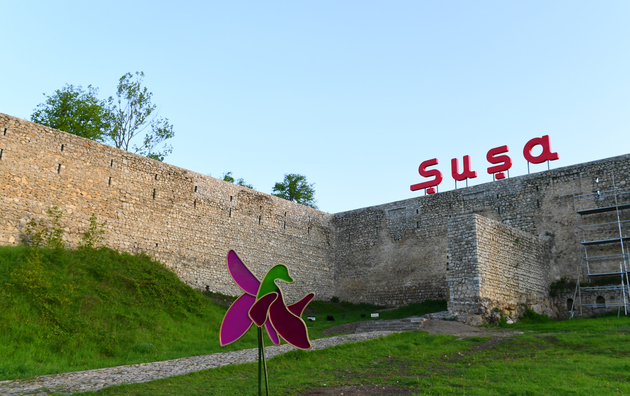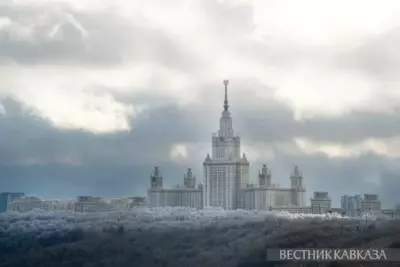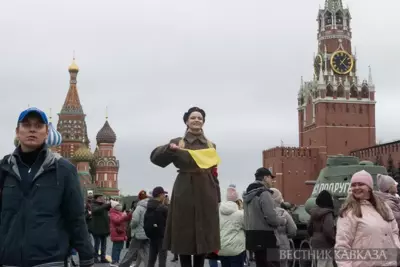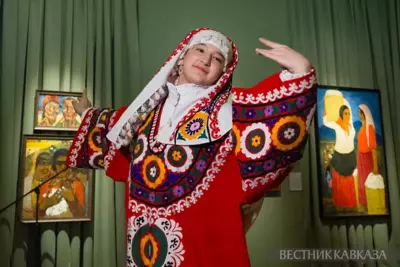One year ago, on the night of November 10, the Presidents of Russia and Azerbaijan and the Prime Minister of Armenia signed a trilateral Statement to end the Karabakh war. The last act of the war, which lasted almost three decades, began on September 27, 2020 with massive shelling of Azerbaijan's front-line and border settlements from Armenia and the occupation zone. This round of hostilities was called the Patriotic War of Azerbaijan, since the Fizuli, Jebrail, Zangilan and Gubadli regions of Azerbaijan, parts of the Terter, Khojavend, Khojaly and Lachin regions, as well as the city of Shusha were liberated from occupation; the occupying troops of Armenia were withdrawn from the Aghdam, Kelbajar and Lachin regions.
This year, Vestnik Kavkaza wrote about each of the 44 days of the Patriotic War of Azerbaijan for six weeks. It's time to sum up the results.

The Military Trophy Park in Baku
Three decades of the Karabakh war
First of all, it is necessary to recall the essence of the 32-year-old Nagorno-Karabakh conflict, which became a thing of the past thanks to the victory of Azerbaijan. The Nagorno-Karabakh conflict was one of the instruments for the artificial collapse of the USSR through the creation of hotbeds of interethnic tension in the union republics. In the case of the AzSSR and the Armenian SSR, the central authorities gave the green light to local ultranationalists, who, on the one hand, proclaimed the Azerbaijani Nagorno-Karabakh Autonomous Region as the ancestral land of Armenians, in connection with which a campaign was started to transfer the NKAO to the Armenian SSR, and on the other hand, began an "ethnic cleansing" campaign in Armenia. In the winter of 1987-1988, many Azerbaijanis living in the Armenian SSR were expelled from their homes, which marked the beginning of the Nagorno-Karabakh conflict.
In Soviet times, a series of bloody clashes took place, the peak of which was a terrorist attack on Baku on the night of January 20, 1990. After the collapse of the USSR, Armenia switched to armed aggression against Azerbaijan - the Karabakh war - and for several years occupied 20% of Azerbaijani territory, ignoring the demands of the UN Security Council to end the war and withdraw troops from the occupied regions. On May 12, 1994, a ceasefire agreement between the parties entered into force, after which unsuccessful peace negotiations on the Nagorno-Karabakh settlement continued for 26.5 years, the ceasefire was violated daily.

Ruins of Aghdam - known as "Hiroshima of the Caucasus"
In the mid-90s, the so-called "Karabakh clan" of ideologists and leaders of the new Armenian ultranationalism came to power in Armenia. Its leaders Robert Kocharian and Serzh Sargsyan ruled Armenia for 20 years until they were overthrown during the Velvet Revolution in the spring of 2018, but the new head of state, Prime Minister Nikol Pashinyan, followed their path and continued to drag out the Karabakh talks until he brought the peace process to a standstill in the summer of 2019 with his "Karabakh is Armenia, period" statement. A year later, Yerevan adopted an aggressive military doctrine "new war - new lands" and soon attacked the Tovuz region of Azerbaijan. In September, Armenia announced the creation of a militia and women's combat units.

Consequences of the July clashes in the Tovuz region
44 days of the Patriotic War
The Patriotic War of Azerbaijan began on September 27, 2020. On Sunday morning, Armenian troops carried out a massive shelling of Azerbaijani border and front-line settlements along the entire border with Azerbaijan and the contact line of troops. To ensure the safety of the civilians, the Azerbaijani army launched a counter-offensive operation. Two main directions were chosen - the northern and southern sides of the front. In the north, on the very first day, dominant heights along the Murovdag ridge were taken, as well as in the Agdere direction, which made it possible to cut off the occupation troops in the northeast from the supply. In the south, four villages of the Fizuli region and two villages of the Jebrail region were liberated from occupation, thus the de-occupation of the Iranian-Azerbaijani border began.

From the first day of the war, Azerbaijan published footage of the elimination of the occupation troops of Armenia
Over the next week, there were battles for control over the northeast of Nagorno-Karabakh, where the so-called 6th fortified area of the occupiers was located, as well as Fizuli and Jabrayil regions. Thus, instead of a frontal attack on the fortifications in the Aghdam region, the tactics of encircling the occupying forces concentrated in the center and east of Nagorno-Karabakh and taking control of the supply routes were chosen. On October 3, the invaders were driven out of the Talysh and Sugovushan villages of the Terter region, and the Armenian Armed Forces' formations in Agder were completely blocked from the northwest. On October 4, the city of Jebrail was liberated. Also, the liberation of the villages around Jabrayil and Fizuli began.

Liberrated Sugovushan
Unable to restrain the advance of the liberation army of Azerbaijan, the Armenian Armed Forces shelled the Azerbaijani front-line villages and cities every day. The city of Tartar was their main target until the very last day. Medium-range missiles were launched from the territory of Armenia on October 3 at the cities of Ganja (the second most populous in Azerbaijan after Baku) and Mingachevir, as well as in the Khizi and Absheron regions close to Baku. In Ganja, the target was the civilian population, in Mingachevir - the energy infrastructure and the largest reservoir in the country. These missile strikes confirmed that Yerevan chose the tactics of terrorist acts against the civilian population of Azerbaijan in order to provoke Baku to any retaliatory actions on the territory of Armenia and thereby involve Russia and the CSTO in the war. Then one person died, as a rocket exploded in a private household in Ganja.

Terrorist attack against Ganja on October 4
On October 9, Moscow hosted hours-long negotiations between the Foreign Ministers of Azerbaijan and Armenia Jeyhun Bayramov and Zohrab Mnatsakanyan, which ended on the night of October 10 with the signing of a ceasefire agreement. A few hours before their meeting, the Azerbaijani army liberated the key settlement of Hadrut in the Khojavend region from the occupation. The ceasefire, in fact, did not happen - the occupation troops continued both shelling of the settlements of Azerbaijan and the fighting in Karabakh. On the night of October 11, new medium-range missiles were launched from the territory of Armenia at Ganja and Mingachevir. In Ganja one of the shells hit an apartment building, killing 10 civilians.

The Ganja terrorist attack on October 11, committed a day after the ceasefire
Over the next week, the Azerbaijani army systematically advanced towards Fizuli, knocking out the invaders from the villages in the Fizuli and Khojavend regions. On the night of October 17, another medium-range missile was launched from the territory of Armenia against Ganja and Mingachevir. In Ganja, the missile hit a residential quarter, 13 people were killed, including a Russian citizen. On the morning of October 17, it became known that Fizuli had been liberated. The Azerbaijani Armed Forces took control of the entire southeast, which had been under occupation for almost 30 years.

The Ganja terrorist attack on October 17
On October 18, Azerbaijani troops reached the famous Khudaferin bridge, which connects the Azerbaijani and Iranian sides of the Araz River, and the strategically important Khudaferin reservoir. Just two days later, on October 20, the soldiers-liberators drove the invaders out of the city of Zangilan and nearby villages. At the same time, there was an active offensive of the Azerbaijani Armed Forces in the Khojavend region from the direction of Hadrut.

Liberated Zangilan
On October 22, shortly before the complete liberation of the Iranian-Azerbaijani border, Armenian troops fired missile launches at the Gabala region, located in the center of the country, Kurdamir region, and the Caspian Siyazan region of Azerbaijan, bordering Russia. On October 23, the Azerbaijani military from the Zangilan region entered the territory of another region bordering with Armenia - Gubadli. On October 25, the city of Gubadli was liberated. In response, on October 27-28, cluster missile attacks were launched from the occupied territories on the Azerbaijani city of Barda; more than 30 civilians were killed in these attacks.

The Barda terrorist attack on October 28
By the end of October, the Fizuli, Jabrayil, Zangilan and Gubadli regions of Azerbaijan were almost completely liberated from the occupying forces of Armenia, the Azerbaijani troops took control of a significant part of Khojavend district. The second Karabakh war was, in fact, lost by Armenia, but Nikol Pashinyan refused to surrender, as he was not satisfied with Baku's condition of returning the city of Shusha to Azerbaijani citizens.

Liberated Gubadli
Azerbaijani troops entered Shusha on November 5 and on November 8 Shusha was completely de-occupied. The Armenian command expected Baku to send an army to Shusha either along the main road from Lachin to Khankendi, or along the road in the southeast through the Red Bazaar, however Baku relied on a special forces operation. The special forces did not storm the only road serpentine leading to the city, but climbed the steep cliffs. The last supply route of the Armenian invaders was cut from the same direction, the remaining occupation forces in Khankendi, Khojaly, Askeran, Agdera and Khojavend were trapped.

Liberated Shusha
On November 9, the Day of the State Flag of Azerbaijan, the Azerbaijani army liberated 71 settlements in seven regions, including Lachin and Khojaly. Late in the evening, Nikol Pashinyan agreed to surrender, and on the night of November 9-10, a trilateral declaration of Russia, Azerbaijan and Armenia on ending the Karabakh war was signed. According to the document, the Armenian occupation forces were obliged to withdraw from the Kelbajar region by November 15, from the Aghdam region - by November 20, from the Lachin region - by December 1. Russian peacekeepers were deployed to the region to monitor the ceasefire; all refugees and internally displaced persons received the right to return to their native lands. Also, it orders to unblock transport links, including between Nakhchivan and the western regions of Azerbaijan through the territory of Armenia.

Signing of the Tripartite Declaration
Thus, the Karabakh war ended with the victory of Azerbaijan, which liberated its lands first by military, then by political means.






